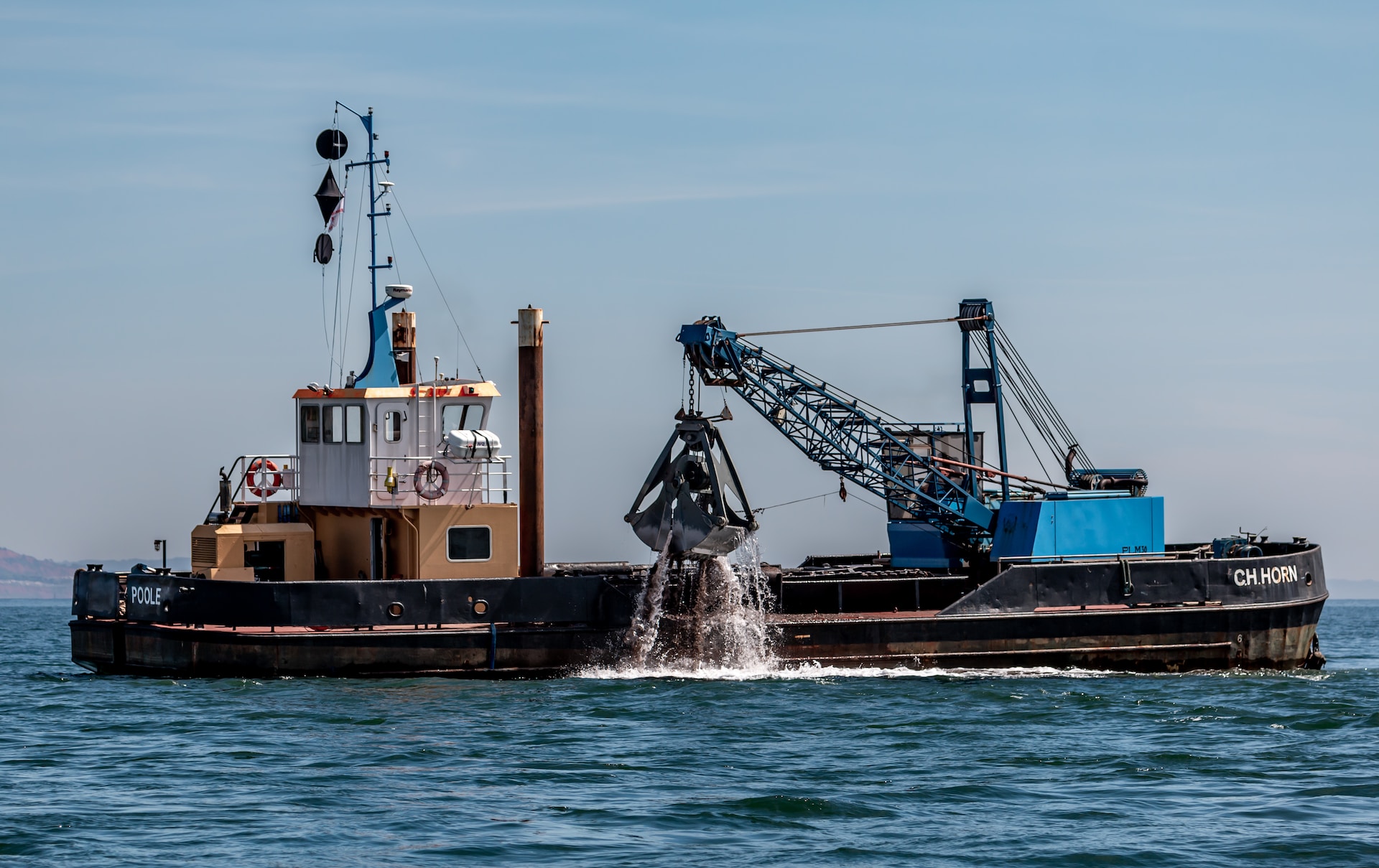A dredger is a type of boat that is equipped with a tool, called a dredge, that draws, sucks, excavates or scrapes sediment such as sand, silt, gravel, trash, rocks, debris and animal and plant matter from the ocean floor, sea bed, lakes or a waterway such as a river, estuary or canal.
The materials moved are then placed elsewhere or disposed of in an act known as dredging.
Dredging is carried out in four acts:
- The material on the bed/bottom is loosened.
- The material is gathered or extracted and brought to the surface.
- The material is transported to Point B.
- The material is disposed of.
And while the dredger might not look like the most glamorous or exciting of vessels, it still plays an important role in maintaining safe and navigational conditions.
This is because many types of sediment are not stationary. For example, sand and silt are continuously moving as they're at the mercy of the movements of currents and tides.
Read more: Everything You Need to Know About Mining Ships
This can become a problem when a waterway, harbor or port needs to maintain a specific depth so that boats and ships can safely sail through or in and out of them.
If large quantities of sediment shift into that waterway or port, it can pose very real danger for the vessels trying to navigate it.
In this article we will take a closer look at the hard working dredger and find out more about what they do, how they operate, and also at different types of dredgers - of which there are quite a few.

Meanwhile, if you’re interested in finding out more about some of the unsung heroes of the shipping industry, why not take a look at some of our other articles about different types of boats, yachts and vessels.
Read more: Everything You Need to Know About Coaster Vessels
For example, the lightship, the icebreaker, the bulk carrier, the fireboat, the car carrier, the cruise ship, the fishing boat, the supramax vessel and the container feeder.But for now, let’s focus on what a dredger does.
What are dredgers and what do they do?
Dredgers work to remove sediment, that much we know. But it’s not only for the purpose of safe navigation and berthing. In fact, rather than just being a nuisance, matter removed from one point on the bed - and depending on its nature - can also be put to good use. For example:
- It can be used to create new harbors.
- It can be used to create new shipping channels.
- It can be used to reshape features on land or in the water to reconfigure or improve drainage.
- It can be used to restore sandy beaches which have been damaged by coastal erosion.
- It can be used to construct dikes and dams.
- It can be used to help create the foundations for new bridges, docks, wharves or piers.
Read more: Everything You Need to Know About Tugboats
There are other situations in which dredging is employed too, for example:
- To collect marine life that has commercial value.
- To reclaim areas that have been damaged by manmade or natural disasters such as oil spills or underwater volcanic eruptions.
- To remove contamination from the sea bed or ocean floor.
- To make it easier to fish in shallow waters.
- To gather mineral deposits that have commercial value.
The problem with dredging
Dredging does have a controversial reputation, however, because it can be extremely damaging to the marine environment and the creatures and organisms that inhabit it. Indeed, much has been written about the harmful impacts of dredging, but to summarize, dredging can:
- Damage or destroy ecosystems on the sea bed.
- Disturb the very sediment it is removing which can pollute the water.
- Destabilize river banks.
- Cause sediment to smother seagrasses. These are the main food source for sea turtles and dugongs.
- Damage corals including such sites as the Great Barrier Reef.
So why is dredging still used? That’s because in some situations there is no other perceived suitable alternative method.

The history of dredging
Not surprisingly, as shipping and trade and commerce evolved, dredging also had an important part to play. From as far back as 1000 BC, harbors were rapidly being constructed in the Mediterranean, with evidence of dredging being found.
Read more: Everything You Need to Know About Cable Laying Ships
In the French port of Marseille, dredging is said to have been recorded from the third century BC and indeed the remains of a trio of dredgers were found on the harbor bed there.
In 4000 BC and not so long after the construction of the pyramids, the branches of the River Nile and adjacent wharfs were thought to be constructed through use of dredging.
And fast forward to 1859 where dredgers were used to help construct the Suez Canal and then again to 1914 when the Panama Canal, which relied hugely on dredgers, was completed.
What are the different types of dredger vessels?
Like tankers which can be broken down into gas tankers, oil tankers, and chemical tankers, there are a number of different types of dredger and these are categorized by their means of dredging.
Read more: Everything You Need to Know About Pilot Boats
Generally speaking there are three main categories of dredger: hydraulic dredgers, mechanical dredgers, and other miscellaneous dredgers. We’ll take a look at each category and at the different dredgers which fall into those categories.

What are hydraulic dredgers?
As you may have guessed from the name, these dredgers dredge sediment and other material by using suspension and a pumping mechanism. Anything dredged is pumped through the system and into outlet pipes.
They also change the sediment’s existing formation by adding large quantities of water to it.
Read more: Everything You Need to Know About LNG & LPG Tankers
This makes it possible to displace finer materials, whilst the hydraulic system is able to better cope with this type of matter as heavier matter is more difficult to hold in suspension.
Now we’ll look at some common types of hydraulic dredgers.
Water injection dredger
Commonly used for jobs or projects that require sensitivity to the environment, water injection dredgers bring fluidity to the material being dredged by pumping water into it. This then allows the matter to be naturally carried away by a combination of gravity and the tide or current, or moved by directing a jet of water at it.
Water injection dredgers are normally used in harbor scenarios where sand or mud needs to be dredged for maintenance or repair.
Suction dredgers
Suction dredgers are further broken down into two different types: Cutting suction dredgers (CSD) and plain (or profile) suction dredgers. They function in similar ways but the CSD has a cutting tool at the suction inlet. This assists in loosening sand, soil or sediment so it can be more easily suctioned.
A powerful pump helps suck the dredged matter up through the vertical suction pipe after which it is expelled through a pipeline or loaded into a barge.
Trailing suction hopper dredger

Used mainly for harbor maintenance and pipe trenching, the trailing suction hopper dredger (TSHD) (yes, we think it’s a mouthful too!) is a self-driving dredger that stores the dredged material in a spacious hold onboard, called a hopper.
This material can then be transported to its destination and discharged by either using a pump to offload it somewhere offshore, or by opening doors, gates or valves located in the bottom of the vessel while the hopper is elevated using winches or cranes.
Read more: Everything You Need to Know About Offshore Vessels
Good for use in land reclamation, hopper dredgers normally dredge softer materials from everywhere from seas and estuaries to canals and rivers.
What are mechanical dredgers?
There are a few defining characteristics to mechanical dredgers: they are good at getting rid of debris or matter that has been hand-packed, and they are also suited to working in confined areas.
Mechanical dredgers come in a number of different shapes and sizes but their method of sediment removal works on the same principle. A bucket or a grab is lowered onto the sea, lake, river or other waterway bed and then scoops or ‘grabs’ the sediment before lifting the bucket/grab so that the material can be deposited and then transported to its end destination. This method is known as hand-packing.
Now we’ll look at some common types of mechanical dredgers.
Grab dredgers
Also known as clamshell dredgers, these vessels are secured by anchors or something called spud poles (a type of mooring pole which is driven into the sea bed), making them stationary.

As the name clamshell dredger suggests the dredging tool on these dredgers is made up of two halves of a shell-like grabber. The grab is mounted on a hydraulic excavator or a dragline.
Once the clamshell has a full grab of sediment or material it deposits its load into a barge for onward transportation.
Grab dredger fast facts:
- They are most commonly used for collecting loose sand, clay and excavating mud in bays.
- A grab or clamshell dredger has a capacity of anywhere between 1 and 20m³ depending on crane power.
- The capacity of a grab hopper dredger (a crane that is placed upon a pontoon or a hopper vessel) is anywhere between 100 to 2,500m³.
- Grab dredgers are particularly useful when it comes to the removal of material that is close to harbor walls, or in the corners of a basin or dock.
Bucket dredgers
Like grab dredgers, bucket dredgers are also stationary, being secured by anchors, however they are able to move in a semi-arc whilst operating thanks to the use of winches.
They work by utilizing a perpetual chain of buckets which scrape the material from the bed, thereby loading the buckets with it. The full buckets are then positioned over a waiting barge and turned upside down to tip the material into it.
Bucket dredgers are the oldest variety of mechanical dredgers.
Backhoe dredgers
You may also see the backhoe dredger referred to as a dipper dredger. These use a bucket or a semi-open shell with a 0.5 to 13m³ capacity to dredge and are hydraulically driven. As with the clamshell, material is deposited from the bucket or shell into barges.

Not dissimilar to the excavators or diggers we see being used on land, the backhoe is used primarily for dredging in shallow waters for example in harbor maintenance, although some of the latest backhoe and dipper designs allow for dredging in deeper waters.
Bucket ladder dredgers
Similar to the bucket dredger, this dredger uses buckets to collect material. However the buckets are mounted on a wheel. Despite their ability to collect hardened matter such as coral and soft rock, the bucket ladder type is not typically used anymore.
This is due to the fact that they are incredibly noisy (something which has a negative environmental impact) and they also require more anchor lines compared to a traditional bucket dredger.
Miscellaneous dredger types
So now we come to the types of dredgers that don’t fall under either the mechanical or hydraulic dredger umbrellas. Rather than being multi-purpose, these dredgers are more likely to be designed and built for an explicit reason.
All these other types of dredgers normally ply their trade in shallow waterways such as narrow canals, industrial lagoons and reservoirs. They include:
Reclamation dredger
Like the trailing suction hopper dredger, this vessel is, no surprise, normally used for land reclamation. You may also hear the reclamation dredger called a barge unloading dredger.
Air-lift dredgers and jet-lift dredgers
A jet-lift dredger uses the Venturi effect (when fluid pressure is reduced when the fluid flows through a constricted section of a pipe.) A rapidly moving jet of water is injected into the material which forces the surrounding water and the material into a pipe.

An air-lift dredger operates on a similar principle except it uses high pressure air to activate the jet of water that forces the water, and the dredged material, into a pipe.
Jet-lift and air-lift dredgers are best suited to softer, finer materials as opposed to rock etc.
Pneumatic dredgers
If you want to understand how these dredgers work, think about your hoover that you use at home. A pneumatic dredger has a system consisting of a chamber that has a high pressure vacuum inside of it.
The chamber is suspended by a crane and the material is pumped into the chamber through the pressure. This method only really works for material that flows without issue.
Augur suction dredgers
We talked earlier about the mechanical cutter suction dredgers: Augur suction dredgers work on the same principle with the main difference being that the latter are equipped with a rotating Archimedes screw which is located perpendicular to the suction pipe.
This screw turns and removes the material after which it is sent to the suction pipe. Augur suction dredgers are employed when the material in question needs to be dredged in exacting horizontal and vertical dimensions.
Bed leveling or plough leveler dredgers
Two names for the same dredger - you may hear both of these used interchangeably. Unlike its cousins, this dredger is equipped with a long cutting blade. As the dredger advances across the bed, the blade scrapes the bottom until it is the required depth.
Amphibious dredgers
A leap forward in dredger technology - the amphibious dredger often has long legs which are hinged, allowing it to work both as a regular vessel and one that stands on the bed to keep its hull above the water line. They remove material from the bed using a shovel, buckets or a grab.
Fishing dredgers
As the name suggests, these are used to gather seafood for sale and consumption from the sea bed. Main catches include oysters, mussels, clams and scallops although some fishing dredgers are also capable of harvesting sea cucumbers, conch, sea urchins and crabs.

The dredger is towed by a regular fishing boat and the catch is collected by a chain mesh scoop. Some fishing dredgers are designed purely to harvest clams and use hydraulic injection to bury down into the sand on the sea bed to find their prey.
Want to learn more about different types of vessels?
Why not take a look at some of our other blog posts about different types of working vessels?
Want to dive into what cargo and container ships or passenger ferries are really all about? We have you covered. Ever wondered what a roro ship or a crane vessel is? No problem.
Wondering what heavy lift vessels actually are? Check out the rest of this series of articles.
Read the previous article in this series: Everything You Need to Know About Car Carriers
Read the next article in this series: Everything You Need to Know About Fireboats

Eve Church
Eve is Martide's content writer, publishing regular posts on everything from our maritime recruitment and crew planning software to life at sea. Eve has been writing professionally for more than two decades, crafting everything from SEO-focused blog posts and website landing pages to magazine articles and corporate whitepapers.
UK

is the only site for maritime jobs



